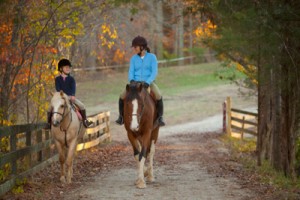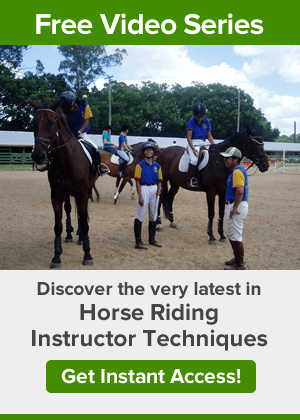Tips For Teaching Children’s Horse Riding Lessons

If you were one of the people who took our recent survey, THANK YOU! In particular, if you were one of the people who asked for some tips for teaching children then this series of tips for teaching children’s horse riding lessons has been written for you!
1. Keep Children Active And Moving In Their Riding Lessons
Children like active riding lessons with maximum participation. Once they have learnt their A, B & C’s (attitude, balance and control) they generally love to canter and jump.
They like to keep moving, but rather than having the ride go in single file behind one leader for the whole lesson try these suggestions
– change leaders
– go into and out of open order
– leading files in succession to perform a specific arena movement
– same size satellite circles returning to the same place in the ride (see ‘Arena Exercises’)
– two rides in single file going in opposite direction
– including across the diagonal (remember three horses distance)
2. Use A Broad Range Of Horse Riding Activities
For children to maintain interest it is essential that their riding lessons be well planned with a broad range of activities within each lesson. This could include
– lots of arena figures
– changes of rein
– transitions between paces
– different types of gymnastic jumping exercises (see ‘Gymnastic Jumping Exercises’)
– learning games
3. Modify Horse Riding Activities For Younger Students
Children often lack the fine motor skills, attention span and strength required to school horses and improve them at the same level as an adult. Growth periods will alter a child’s coordination and skills so the requirements for adult lessons are best modified.
An example would be that rather than increasing the difficulty of jumping by making the fences higher there should be a focus on more easily assessed improvements that they can correct within the lesson such as
– number of steps/ strides between transitions
– number of strides between fences
– approaching and departing between witches hats (see ‘Jumping Accuracy’)
4. Break Down Complex Horse Riding Skills
Children have short attention spans and are unable to process too much information at once. If they are learning a more complex task such as a dressage test,
– introduce one new movement at a time
– keep instructions or questions short and simple
– allow time to learn this new movement
Once the individual movements are learnt, a few of them can be strung together at the end of the lesson or the complete test after a series of lessons.
5. Allow Children To Be Creative In Their Riding Lessons
Children enjoy being creative, so allow them to assist you in creating the lesson
– teach by stories and let them fill in the gaps, at the same time controlling the excess talking! (see ‘Horse Riding Fantasy’)
– change leaders and give the leaders responsibility for the speed of the pace
You can also allow leaders to
– choose which way to turn
– choose the next arena movement
– choose where the movement is done
6. Maintain Children’s Interest During Their Riding Lesson
This includes planning a variety of activities within their riding lesson. Children get bored easily, even when they are riding their ponies. If you are working towards improving a particular skill with either them or their pony/ horse then plan to teach the improvement of that skill through a variety of activities, games etc.
If you are teaching children how to ride a show jumping course, they can
– practice two-point position (this is a particularly good exercise for active kids and unfit ponies)
– while working on accuracy
– riding the line of the course and
– through a few transitions (saluting the judge and commencing the course)
– single jumps (the warm-up)
– quiz on the show jumping rules (while another student is jumping the course)
– quiz on the five phases of jumping (while the ponies are having a rest)
7. Limit Talk In Horse Riding Lesson
Children are very social and love to catch up with other students in their riding lessons, particularly if this is the only time they have the opportunity to meet. During their riding lesson it is best to maintain the focus on the horses and their lesson. Verbal interactions should be with the riding instructor so they use this lesson time to absorb information and practice their horse riding skills.
If they continually talk about an unrelated subject during the lessons, some strategies could be
– keeping them physically active and increasing the difficulty of what they are riding
– when an individual student is performing a task, stand them in different corners of the arena to watch (will vary with riding skill)
– provide the opportunity for them to socialize before and/ or after their riding lesson
8. Increase Time At The Riding School/ Equestrian Centre
Create opportunities to increase the length of time spent within the horse environment at your riding school/ equestrian center. This gives children the opportunity to learn more around horses and if managed properly can save you time as they perform the tasks that are easily delegated.
Depending on the temperament and experience, they can assist you in the preparation of lessons and care of the horses. For less experienced children, they can fill water buckets, clean stables, rake pathways and clean gear.
9. Teach Individuals Within A Group Horse Riding Lesson
Children develop at different rates. In the situation of equal age and horse riding experience, there will be early and late developers in any group and have different levels of natural ability. You should also take the individual horses/ ponies into consideration.
In a flatwork lesson, while maintaining correct ride distance there can be;
– some students improving their lateral work
– while others are focusing on correct flexion and bend of their horse
– less experienced riders maintaining ride distance and position corrections.
In a jumping lesson, there can be two (or several) exercises set up at levels/ difficulty appropriate for individual children and their ponies.
10. Give Lots of Positive Comments And Be Constructive
It is human nature to thrive in a positive supportive environment and children are no different. They can be sensitive to criticism and failure and need positive comments and encouragement. However they also need to learn the best way to do things and to build on their skills, so constructive comments on how to improve included in the lessons.
Every child is different. Some children may need 99 positive supportive comments to allow them to be open to receiving one piece of advice on how to improve. More mature professional riders may be open to 99 constructive comments on how to improve to every one positive comment to feel like you are really helping them.
Remember that the learning in every horse riding lesson
is unique, children (and ponies/ horses) develop at
different rates. You will often have riders of
varying abilities within each horse
riding lesson you teach.
Use the tips above to help you to create your riding lessons for children, and remember that your highest priority is the safety of the children in your lessons.
Happy Riding,
Glenys 🙂

